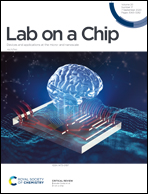Biomimetic construction of peritoneum to imitate peritoneal metastasis using digital micromirror device-based optical projection lithography†
Abstract
Currently, the mechanisms underlying the peritoneal metastasis of gastric cancer cells and the function of mesothelial cells during this process are unclear, primarily due to the absence of an effective in vitro peritoneal model. In this study, we constructed a biomimetic peritoneal model using a digital micromirror device-based optical projection lithography system. This model enabled the simulation of a damaged peritoneum, which allowed for a comparison of the characteristics of an undamaged peritoneum, such as porosity, mechanical properties, and surface morphology, with those of a damaged peritoneum. Biological inertness and removability of the polyethylene glycol dimethacrylate hydrogel were exploited to fabricate an arrayed heterogeneous interface that imitated a damaged human peritoneum. The porous structure of the peritoneum was achieved by adjusting the ratio of collagen I to gelatin methacryloyl; this structure of the peritoneum might contribute to its shock absorption property. Atomic force microscopy characterization showed that the outermost layers of the model peritoneum and real peritoneum were similar in surface morphology and mechanical properties. Furthermore, we reproduced the process of peritoneal metastasis in vitro. The numbers of gastric cancer cells that adhered to the heterogeneous interface were different, and mesothelial cells played an essential role in peritoneal metastasis. Our findings indicate that this model can be utilized in preclinical drug screening and personalized therapy.



 Please wait while we load your content...
Please wait while we load your content...